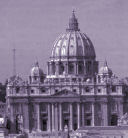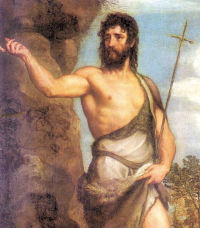Subscribe for free today!
Get newsletters with the latest content, and access to exclusive ebooks and podcast episodes.
Already subscribed? Log in to stop seeing invitations to subscribe.
Advent: December 12th
Third Sunday of Advent
Other Titles: Day 1 O Antiphons: O Sapientia (O Wisdom)
» Enjoy our Liturgical Seasons series of e-books!
"Rejoice: the Lord is nigh." As Christmas draws near, the Church emphasizes the joy which should be in our hearts over all that the birth of our Savior means for us. The great joy of Christians is to see the day drawing nigh when the Lord will come again in His glory to lead them into His kingdom. The oft-repeated Veni ("Come") of Advent is an echo not only of the prophets but also of the conclusion of the Apocalypse of St. John: "Come, Lord Jesus," the last words of the New Testament.
Today is known as Gaudete Sunday. The term Gaudete refers to the first word of the Entrance Antiphon, "Rejoice". Rose vestments are worn to emphasize our joy that Christmas is near, and we also light the rose candle on our Advent wreath.
The Third Sunday of Advent
Once again the central figure of the Advent Liturgy is St John the Baptist. After he had preached the Baptism of conversion and penance, he was arrested due to his public denunciation against the immorality of the time. He invites everyone to be patient and await the arrival of the Messiah who will come to establish a new kingdom. In fact, whilst he was in prison, he sent someone to ask Jesus if it is He ‘who is the one to come or shall we look for another?’(Mt 11: 3) Jesus responds by emphasizing the fruits of His mission which were manifested in His preaching and in the signs of healing and recovery: ‘the blind see again, and the lame walk, those suffering from virulent skin-diseases are cleansed, and the deaf hear, the dead are raised to life and the good news is proclaimed to the poor.’ (Mt 11: 5) He knew that John, knowing the scriptures, would recognize through these signs that the ‘One who will come’ is already here. The prophets had foretold that these signs would accompany Him: ‘Then the eyes of the blind will be opened, the ears of the deaf unsealed, then the lame will leap like a deer’ (Is 35: 6) all ‘will [then] see the glory of Yahweh, the splendour of our God.’(Is 35: 2) Everyone is invited to journey, to found our lives on the ‘Holy Road’. It is exactly on this ‘Road’ that we encounter the Lord Jesus, who is ‘the way’ and there, where we will find our ‘joy and happiness’. We must therefore be confident because God’s salvation manifests itself in fullness: ‘Here is your God; He is coming to save you’ (Is 35: 4) and also to be patient and uncomplaining, or better yet to revitalize our hearts ‘because the Lord's coming will be soon’ (James 5: 8).
‘O people in wait! Those who await you will not be disappointed (cf Ps 24:3). Our Father’s longed for you; all the just from the beginning of the world had hoped in you and were not confounded (cf Ps 21: 6). Already, your mercy was received in the heart of your temple (cf Ps 47: 1), where joyous choirs sing your praises: ‘Blessed is He who comes in the name of the Lord’ (cf Ps 117:26; Mt 21: 9). I have tirelessly waited for the Lord and He has turned His gaze towards me’ (Ps 39: 2). Then recognizing the Divine Master in His fleshy humility they said; ‘See this is our God in who we wait; He will save us! He is the Lord we have awaited Him in fullness and we exult and rejoice in His salvation.’ (Is 25: 9).’ St Hilary of Poitiers Sermon in Advent I)
In this confident expectation, the Virgin Mary sustains us as she is the mother of expectation and hope who gave significance to our patience which has not been disappointed. Thanks to Her, our hope is transformed into salvation; our eyes have seen God’s salvation because She was willing to become the privileged channel through which the Lord was pleased to manifest Himself to humanity.
This joy, invisibly present within us, encourages us to journey on with confidence. A model and support of this deep joy is the Virgin Mary, through whom we were given the Infant Jesus. May She, a faithful disciple of her Son, obtain for us the grace of living this liturgical season alert and hardworking, while we wait. Amen! 1
1 Pope Benedict XVI Celebration of the First Vespers of Advent, St Peters Basilica 28 November 2009
From the Congregation for the Clergy
![]() Today is Day One of the Christmas Novena.
Today is Day One of the Christmas Novena.
Advent Reflection: Stepping Out of the Night
What is Advent? Many answers can be given. We can grumble and say that it is nothing but a pretext for hectic activity and commercialism, prettified with sentimental clichés in which people stopped believing ages ago. In many cases this may be true, but it is not the whole picture.
We can also say that Advent is a time when a kindness that is otherwise almost entirely forgotten is mobilized; namely, the willingness to think of others and give them a token of kindness. Finally we can say that Advent is a time when old customs live again, for instance, in the singing of carols which takes place all over the country. In the melodies and the words of these carols, something of the simplicity, imagination and glad strength of the faith of our forefathers makes itself heard in our age, bringing consolation and encouraging us perhaps to have another go at that faith which could make people so glad in such hard times.
This latter kind of experience of Advent brings us quite close to what the Christian tradition has in mind with this season. It has expressed its view of Advent in the Bible texts which it took as the season's signposts. I will mention just one of them, a few verses from Paul's letter to the Christians in Rome. There he says, "... it is full time now for you to wake from sleep...the night is far gone, the day is at hand. Let us then cast off the works of darkness and put on the armor of light, let us conduct ourselves becomingly as in the day, not in revelling and drunkenness, not in debauchery and licentiousness, not in quarrelling and jealousy. But put on the Lord Jesus Christ..." (Rom 13:11-14).
There are many people, of course, who urge us to get up and awake; "Germany, awake!" was the cry of those who, years ago, were bent on deluding the nation; and today too there are awakenings and uprisings that lead further into darkness instead of out of it. What does Paul mean? He puts very clearly what he means by "night" by speaking of "revelling and drunkenness, debauchery, licentiousness, quarrelling and jealousy."
For Paul, nocturnal revelling with all that goes with it stands for the dark side of human nature, man's being "asleep". For him it becomes a symbol of the pagan world as such, submerged in material things, held fast in the darkness that prevails where there is no truth and which, despite all its decibels and hectic activity, is asleep, because it lives unaware of genuine reality, of the real human vocation.
Nocturnal orgies as the image of a world in ruin—are we not appalled to see how aptly Paul characterizes our present times, which are returning to paganism? For us, "rising from sleep" means arising from conformity with the world and with the times and having the courage to believe and to shake off the dream that causes us to bypass our true vocation and our best possibilities. Perhaps the Advent hymns we hear every year may be lights to us, indicating our path, making us look up and recognize that there are greater promises than those of money, power and pleasure. Being awake for God and for other people—that is the kind of "waking" that Advent has in mind, the wakefulness which discovers the light and brightens the world.
—Joseph Cardinal Ratzinger, Seek That Which is Above

Third Sunday of Advent, Guadete Sunday
Station with San Pietro in Vaticano (St. Peter's in the Vatican):
The Station is at St. Peter's in the Vatican. After the two great basilicas chosen for the first and for the second Sunday in Advent, we come to St. Peter's in the Vatican, a church which shares with the Lateran the chief feasts of the year. It was selected as the station for today, because on this Sunday occurred the final scrutiny or examination of those candidates preparing for the Ordinations usually held on Ember Saturday in December. The original basilica was built by Constantine in 323 over the place where St. Peter was buried.
For more on San Pietro in Vaticano, see:
For further information on the Station Churches, see The Stational Church.






